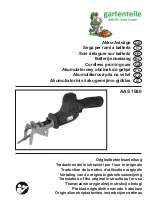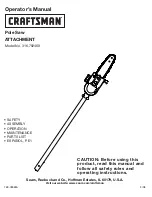
4
GENERAL SAFETY RULES
SPECIFIC SAFETY RULES
b.
Do not force the power tool. Use the correct power tool for your
application.
The correct power tool will do the job better and safer at the rate
for which it is designed.
c.
Do not use the power tool if the switch does not turn it on and off.
Any
power tool that cannot be controlled with the switch is dangerous and must be
repaired.
d.
Disconnect the plug from the power source and/or the battery pack from
the power tool before making any adjustments, changing accessories,
or storing power tools.
Such preventative safety measures reduce the risk
of starting power tools accidentally.
e.
Store idle power tools out of reach of children and do not allow persons
unfamiliar with the power tool or these instructions to operate the power
tool.
Power tools are dangerous in the hands of untrained users.
f.
Maintain power tools. Check for misalignment or binding of moving
parts, breakage of parts and any other condition that may affect the
power tools operation. If damaged, have the power tool repaired before
use.
Many accidents are caused by poorly maintained power tools.
g.
Keep cutting tools sharp and clean.
Properly maintained cutting tools with
sharp cutting edges are less likely to bind and easier to control.
h.
Check for misalignment or binding of moving parts, breakage of parts
and any other condition that may affect the power tools operation. If
damaged, have the the tool serviced before using.
Many accidents are
caused by poorly maintained power tools.
1.
Do not start the saw with the blade in contact with any surface. The saw may
kickback suddenly and could cause injury.
2.
Let the saw blade come to a stop before putting the tool down.
3.
If abnormal noise or vibration occurs, turn off the saw immediately and have
the problem corrected before further uning the tool.
5. BATTERY TOOL USE AND CARE
a.
Ensure the switch is in the off position before inserting the battery pack.
Inserting the battery pack into power tools that have the switch on invites
trouble.
b.
Recharge only with the charger specified by the manufacturer.
A charger
that is suitable for one type of battery pack may create a risk of fire when used
with another battery pack.
c.
Use power tools only with specifically designed battery packs.
Use of
any other battery packs may create a risk of injury or fire.
d.
When battery pack is not in use, keep it away from other metal objects
like paper clips,
coins, keys, nails, screws, or other small metal objects that
can make a connection from one terminal to another. Shorting the terminals
together may cause burns or a fire.
e.
Under abusive conditions, liquid may be ejected from the battery; avoid
contact.
If contact accidentally occurs, flush with water. If liquid contacts eyes,
additionally seek medical help. Liquid ejected from the battery may cause
irritation or burns.
6. SERVICE
a.
Have your power tool serviced by a qualified repair person using only
indentical replacement parts.
This will ensure that the safety of the power
tool is maintained.





































